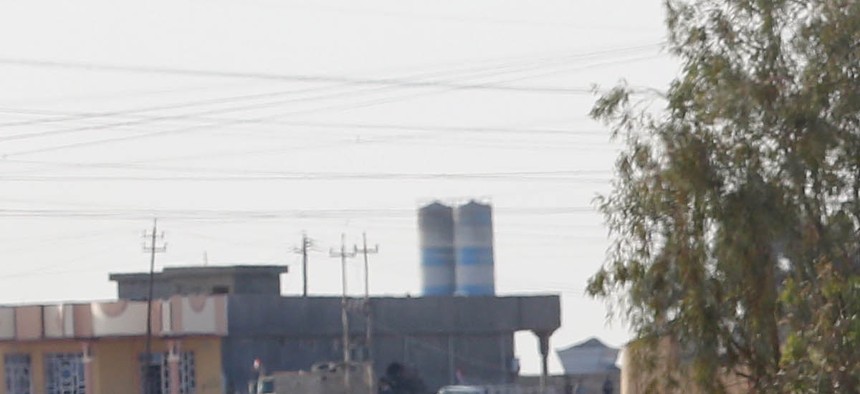
Iraqi security forces are deployed during a military operation to control the villages around the town of Beiji, 250 kilometers north of Baghdad, on December 8, 2014. Mark Wilson/AP
Islamic State Is On the ‘Defensive’ As a Coalition Builds in Iraq
The U.S. war commander in Iraq says ‘you don’t see a lot of movement” by ISIS these days, but you might see more international troops enter the fight soon. By Gordon Lubold
KUWAIT CITY, Kuwait – The war commander for the international effort against the Islamic State said the group is on the “defensive” and that coalition nations will soon be pledging to send hundreds more troops to join U.S. forces in Iraq.
Lt. Gen. James Terry, the commander of what’s now called Joint Task Force Operation Inherent Resolve, said the Islamic State is less on the offensive and more focused on holding ground, making it easier to target them.
“I would just characterize it as ISIL operationally probably on the defense trying to hold what they had gained yet still able to conduct some limited attacks,” Terry told reporters traveling with Defense Secretary Chuck Hagel in the region on Monday.
Terry’s characterization of the jihadist fighters signals a positive, tactical development but does not amount to any kind of a turning point in the fight against the extremist group, which he said has “no respect for humanity.”
Terry’s remarks come as Iraq and Syria remain steeped in violence and amid reports that Israel had launched airstrikes against Damascus, making all the more knotty an already geopolitically complex battlefield.
But the work the U.S. and the international coalition has done to help the Iraqi Security Forces and the more than 1,200 airstrikes launched against the Islamic State has helped to slow the group down, Terry said. At the same time, the “self-declared Caliphate” is challenged to provide governance to people living in areas it has already taken, Terry said. Initially, he said, jihadist fighters had been moving quickly from one battlefield to the next, but since they’ve slowed down, they’ve been easier to target.
(Related: The Fight Against ISIS Is Creating Three Separate Armies in Iraq)
“Quite frankly, when they stick their head up now, we make sure that capability is degraded. You don’t see a lot of that movement that you used to see out there,” he said.
In the meantime, the Iraqi forces have conducted as many as 15 separate military operations against the Islamic State, including retaking the Haditha Dam, a critical piece of Iraqi infrastructure on the Euphrates River.

That kind of effort has helped the fight against the group to become “stalemated” in some cases, as in western Iraq’s Anbar Province. In other areas, the Iraqi forces seem to have the upper hand, he said.
Last year, Terry finished up a tour as the deputy commander of the war in Afghanistan. Now as the commander of U.S. Army Central – the Army’s top commander within the U.S. Central Command area of responsibility, he is also the commander of the Pentagon’s war efforts in Iraq and Syria.
There are no easy answers to the problem posed by the Islamic State, but the Obama administration has long been criticized by members of Congress, some military experts and the like for lacking a coherent strategy. Although top Pentagon officials are wary of becoming too engaged militarily, there is quiet frustration surrounding Obama’s insistence that there be no “combat boots on the ground,” which means U.S. troops will not engage in direct combat. In some cases that has hamstrung the U.S. military, limiting its options as it tries to neutralize the group.
“We now have the world's most powerful air force doing pinprick strikes against empty buildings in many occasions. And that's because we have not got forward air controllers on the ground to identify these targets,” Sen. John McCain, R-Ariz., said Sunday on Fox News’ “Sunday Morning Futures.”
President Barack Obama has made two authorizations for a total of up to 3,100 ground troops to conduct assessments and train and advise the Iraqi forces, though none officially are considered combat forces. Of those, there are 1,650 U.S. military personnel in Iraq, according to a Pentagon spokesperson.
That number is adequate, Terry said, while leaving the door open for a request for more troops. “That’s about what we need, that is what we need right now,” he said, correcting himself. “I’m personally comfortable with that.”
Asked about the need for what’s known as forward air controllers, who can help call in airstrikes against the Islamic State, Terry said the U.S. already has the capability to identify targets using Intelligence, Surveillance and Reconnaissance, or ISR, assets. But if he needs more military personnel to aid in the effort, he’ll seek them, he said.
Terry’s comfort level with the number of U.S. troops he already has stems from the knowledge that he knows more are coming – even if they won’t be wearing American military uniforms.
There are more than 30 nations contributing to the international coalition fighting the Islamic State, with as many as a dozen of those nations conducting airstrikes along with the U.S. And of those, there are 500 military personnel on the ground in Iraq.
But there are about to be more. More than 30 partner nations met last week for a “coalition integration conference” in the region and are making plans to commit a as many as 1,500 troops more to the war effort, primarily to conduct train-and-assist missions with Iraqi and Peshmerga forces. In total, that would amount to more than 3,000 American and international troops participating in the effort.
“What we’re trying to do is nail down specific numbers,” Terry said.
But not all the countries contributing to the effort will be doing so publicly.
“Some countries wish to be overt in their support,” said Gary Boucher, a spokesman for the Joint Task Force. “Some prefer to contribute quietly and we respect their wishes.”
